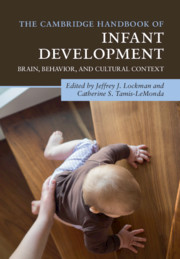Book contents
- The Cambridge Handbook of Infant Development
- The Cambridge Handbook of Infant Development
- Copyright page
- Dedication
- Contents
- Illustrations
- Contributors
- Preface
- Part I Foundations
- 1 Embodied Brain Model for Understanding Functional Neural Development of Fetuses and Infants
- 2 Infant Physical Growth
- 3 Dynamic Epigenetic Impact of the Environment on the Developing Brain
- 4 Brain Development in Infants
- 5 Development During Infancy in Children Later Diagnosed with Autism Spectrum Disorder
- Part II Perceptual Development
- Part III Cognitive Development
- Part IV Action
- Part V Language
- Part VI Emotional and Social Development
- Index
- References
5 - Development During Infancy in Children Later Diagnosed with Autism Spectrum Disorder
from Part I - Foundations
Published online by Cambridge University Press: 26 September 2020
- The Cambridge Handbook of Infant Development
- The Cambridge Handbook of Infant Development
- Copyright page
- Dedication
- Contents
- Illustrations
- Contributors
- Preface
- Part I Foundations
- 1 Embodied Brain Model for Understanding Functional Neural Development of Fetuses and Infants
- 2 Infant Physical Growth
- 3 Dynamic Epigenetic Impact of the Environment on the Developing Brain
- 4 Brain Development in Infants
- 5 Development During Infancy in Children Later Diagnosed with Autism Spectrum Disorder
- Part II Perceptual Development
- Part III Cognitive Development
- Part IV Action
- Part V Language
- Part VI Emotional and Social Development
- Index
- References
Summary
Autism spectrum disorder (ASD) is a heritable, heterogeneous, and common neurodevelopmental condition defined by impairments in social communication alongside restricted and repetitive behaviors (RRB). ASD is a moving target; its definition has changed dramatically over the years. The first comprehensive clinical descriptions of the condition were given by Leo Kanner and Hans Asperger more than 70 years ago (Asperger, 1944; Kanner, 1943), but it was not before 1980, with the publication of the third edition of the Diagnostic and Statistical Manual (DSM) of the American Psychiatric Association that the term autism was introduced as a formal category. At that time, only one criterion related to social interaction was listed (pervasive lack of responsiveness to other people).
Keywords
Information
- Type
- Chapter
- Information
- The Cambridge Handbook of Infant DevelopmentBrain, Behavior, and Cultural Context, pp. 128 - 154Publisher: Cambridge University PressPrint publication year: 2020
